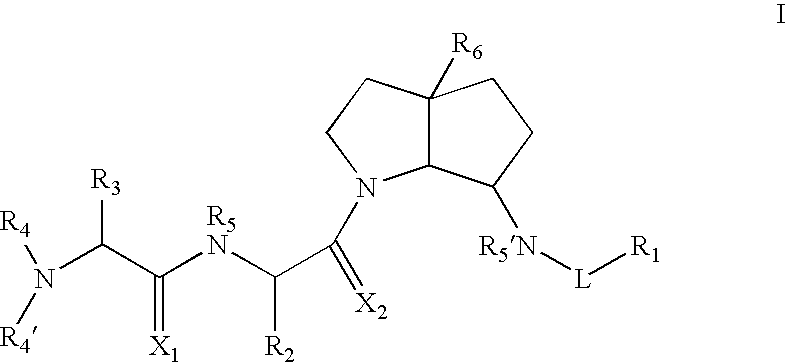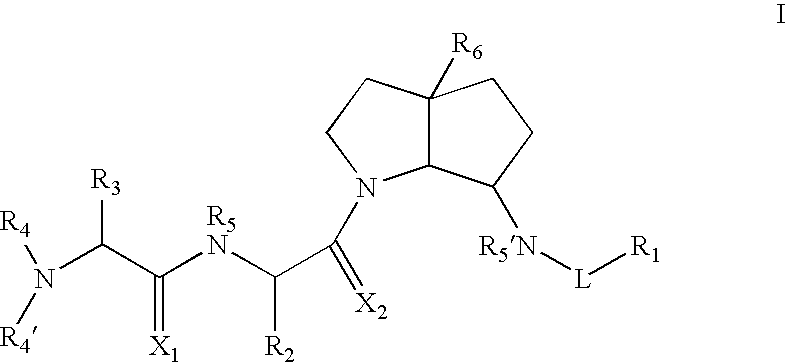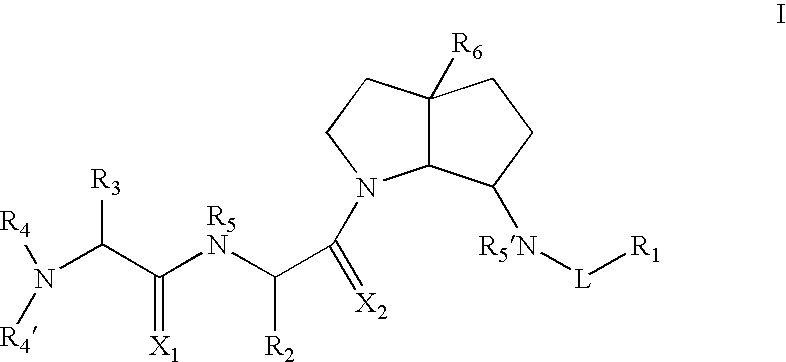Azabicyclo-octane inhibitors of IAP
a technology of azabicyclooctane and inhibitors, which is applied in the field of organic compounds, can solve the problems that chemotherapeutic agents are significantly less effective in killing cells, and achieve the effect of inhibiting binding
- Summary
- Abstract
- Description
- Claims
- Application Information
AI Technical Summary
Problems solved by technology
Method used
Image
Examples
example 1
[0100]The 2-azabicyclo[3.3.0]octane rings were prepared according to the procedures in Corey et al, Tetrahedron Letters, 1989, 30:5547.
[0101]
[0102]EDC (38.34 g, 200 mmol), DMAP (2.44 g, 20 mmol), cyclopentene acetic acid (25.0 g, 198 mmol), and R-α-methyl benzyl amine (25 mL, 196 mmol) were added sequentially to CH2Cl2 (500 mL). The solution was maintained at rt. for 2 h, then washed with 1N HCl (3×100 mL), 1N NaOH (3×100 mL), brine (1×100 mL), dried (Na2SO4), filtered, and concentrated to afford 43.7 g (97%) of amide 3 as a colorless solid.
[0103]
[0104]To a solution of amide 3 (43.6 g, 190 mmol) in THF (430 mL) at 0° C. was added lithium aluminum hydride (200 mL of 1.0M solution in THF, 200 mmol) over 2 h. The mixture was allowed to warm to rt, then heated at reflux for 36 h. The mixture was cooled to 0° C., then water (7.6 mL) was added drop wise, followed by 15% NaOH (8 mL) water (24 mL). The resulting mixture was stirred vigorously over night, then filtered through a pad of Celit...
example 2
[0109]
[0110]Amine 7 (140 mg, 0.61 mmol) was coupled with diphenyl acetic acid (148 mg, 0.7 mmol) following the typical EDC coupling procedure to provide 263 mg (88%) of amide 8 as a colorless oil.
[0111]
[0112]A mixture of benzyl amine 8 (263 mg, 0.62 mmol), acetic acid (71 μL, 1.24 mmol), 20% Pd(OH)2.C (62 mg), and MeOH (6 mL) was maintained under 1 atm. of H2 for 8 h. The mixture was filtered through a pad of Celite, and concentrated. The residue was dissolved in CH2Cl2 (50 mL) and washed with 1N NaOH (3×10 mL), brine (1×10 mL), dried (Na2SO4), filtered, and concentrated to afford 200 mg (100%) of amine 9 as a colorless oil.
example 3
[0113]
[0114]A mixture of secondary amine 1 (166 mg, 0.61 mmol), CbzNt-butylglycine (166 mg, 0.61 mol), HATU (475 mg) DIPEA (1 mL) and DMF (3 ml) was maintained at RT 1 hr. The mixture was diluted with CH2Cl2 (50 mL) and washed with 1N HCl (3×20 mL), dried (Na2SO4), filtered, and concentrated. The residue was purified by flash chromatography (SiO2, 35% ethyl acetate-hexanes) to afford 400 mg (>100%, excess wt. is solvent) of 2 as a colorless oil, which was carried on directly.
[0115]
[0116]A mixture of the amide 2 from above, MeOH (15 ml), AcOH (0.3 ml) and 20% Pd(OH)2.C (150 mg) was stirred vigorously under an atmosphere of H2 for 3 h. The mixture was filtered through Celite, with excess MeOH. The MeOH was removed under reduced pressure, and the residue was dissolved in CH2Cl2 (50 mL) and washed with 0.5N NaOH (3×10 mL), dried (Na2SO4), filtered, and concentrated to afford 169 mg (72% over 2 steps) of amine 3 as a colorless oil.
[0117]
[0118]Amine 3 (169 mg, 0.44 mmol) was coupled with ...
PUM
| Property | Measurement | Unit |
|---|---|---|
| pH | aaaaa | aaaaa |
| proteolytic processing | aaaaa | aaaaa |
| resistance | aaaaa | aaaaa |
Abstract
Description
Claims
Application Information
 Login to View More
Login to View More - R&D
- Intellectual Property
- Life Sciences
- Materials
- Tech Scout
- Unparalleled Data Quality
- Higher Quality Content
- 60% Fewer Hallucinations
Browse by: Latest US Patents, China's latest patents, Technical Efficacy Thesaurus, Application Domain, Technology Topic, Popular Technical Reports.
© 2025 PatSnap. All rights reserved.Legal|Privacy policy|Modern Slavery Act Transparency Statement|Sitemap|About US| Contact US: help@patsnap.com



